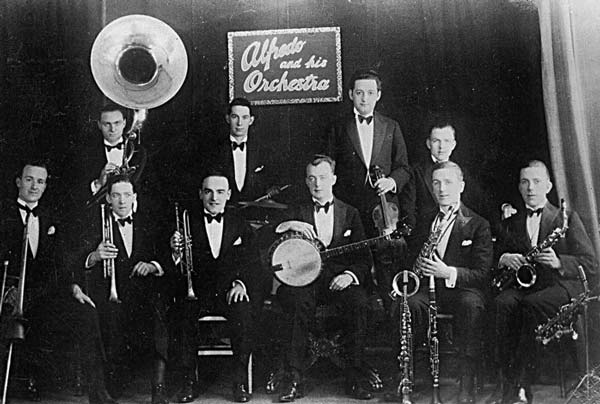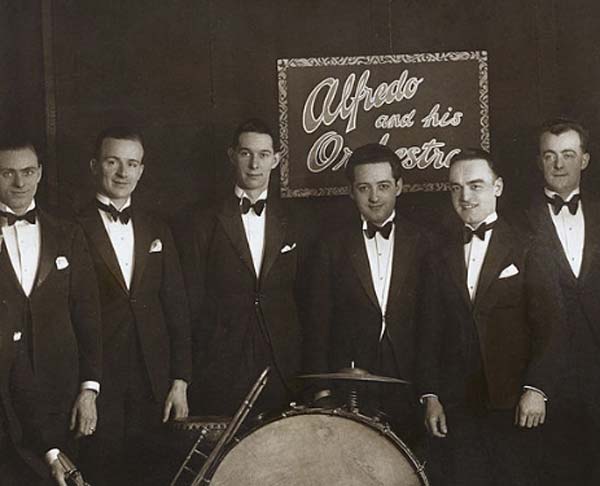Alfred Gill Jr:
(Newark, New Jersey, 18 July 1892 – London, 5 February 1966). Alfredo
Alfredo was a child prodigy and playing violin with The Haydn Orchestra of New Jersey in 1903. By 1907 he was touring the vaudeville circuit with his successful solo act, Alfredo – The Vagabond Violinist. This lead to a tour of the UK.




TIMELINE:
- 1913: Alfredo made his London debut at the Empire, Leicester Square. He then went on a very successful 3-year world tour of Europe, Australia and South Africa. The Australian tour got rave reviews in the local press.
- 1916 - 1922: He continued touring the UK, South Africa and Europe. The Alfredo Rag was published on sheet music.
- 1922: In December 1922 he joined the Jack Hylton Orchestra and made his first recordings.
- 1924: He forming his own Dance Band, Alfredo & his Band. This lead to a joint residency at Prince’s Restaurant in Piccadilly, split with the New Prince’s Toronto Band which featured Alfie Noakes, Hal Swain and Les Allen. This was followed by a three-month contract at the Grafton Galleries in Mayfair and another tour of the UK.
- 1925: Alfredo made his first BBC radio broadcast on 17th March 1925 from the Ulster Hall in Belfast. He also was now contracted to Edison Bell and began recording with his band. The year finished with weekly broadcasts from the Prince’s Restaurant featuring Alfredo and His Band and The Toronto Band.
- 1926: Alfie Noakes joined the Alfredo band as the Toronto band began touring abroad. The Alfredo band also started working with theatre troupes appearing in “The Blue Kitten” and the US comedy musical “Sunny”. They were also regularly broadcasting from Prince’s and record sales were booming. When “Sunny” went on tour, Alfredo was asked to accompany them on tour. Too much work for just one band, so Alfredo started the Alfredo’s Band Agency to provide bands for the many new projects offered him.
- 1927-29: Les Allen, the soon to become popular crooner, joined the band on saxophone and vocals. Success continued with several Alfredo outfits performing all over the country in theatre reviews and Dance Band venues. Record sales increased and were now also being pressed on the budget 8” Edison Radio label. Alfredo based himself at Prince’s from where he also continued to broadcast but by the end of 1929 had decided to leave Prince’s for good and went on tour.
- 1930: The first half of the year was spent on non-stop touring. The second half was spent touring with the aptly named review “Road Show”. He also managed to squeeze in some last recordings for Edison Bell. These four sides featured duets by Al Bowlly and Les Allen.
- 1931: The year started as hectic as ever but by the middle of the year, Alfredo had disbanded and returned to simply playing violin. He went to Paris and put together a gypsy group, returning to the UK as Alfredo and his Vagabonds. Often appearing as Alfredo and his Gypsy Vagabonds and then as Alfredo and his Gypsy’s. Here is “You Will Remember Vienna” from the Pathé YouTube channel.
- 1932: The change in music direction was a huge gamble. This at a time, that most people think of as being the heydays of the British Dance Band scene. In a Melody Maker article, he wrote, “I am certain that the public are tiring of jazz. Syncopated music is all very well, but we are beginning to get it for breakfast, dinner, tea and supper.” The gamble miraculously paid off. His “Gypsy” band was a hugely successful touring extravaganza. There was less broadcast work but Alfredo extensively toured the UK and the continent throughout the remainder of the 1930’s.
- 1934-39: Here’s another Pathetone video from 1934 of Alfredo and his Gypsy’s on YouTube:
Alfredo remained busy for the rest of the 1930’s with a few broadcast, performances at Exhibitions and his regular residency now at the New Victoria Cinema. He appeared on television and recorded commercials and also recorded for HMV. As war broke out, his musicians started to disappear to conscription. He decided to retire. - 1941: He was soon forced out of retirement. “The Phoenix Theatre has persuaded Alfredo out of retirement, where his band takes a leading part in the production, ‘Flying Colours’.” This time the musicians were mainly women, mostly accordionists.
- 1943-49: He did a few reviews but slowed down due to ill health. By the end of the 40’s he had disbanded.
- 1950-51: He made a few solo appearances but soon settled into retirement.
- Alfred Gill died on 5th February 1966